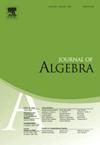On finite permutation groups of rank three
IF 0.8
2区 数学
Q2 MATHEMATICS
引用次数: 0
Abstract
The classification of the finite primitive permutation groups of rank 3 was completed in the 1980s and this landmark achievement has found a wide range of applications. In the general transitive setting, a classical result of Higman shows that every finite imprimitive rank 3 permutation group G has a unique non-trivial block system and this provides a natural way to partition the analysis of these groups. Indeed, the induced permutation group is 2-transitive and one can also show that the action induced on each block in is also 2-transitive (and so both induced groups are either affine or almost simple). In this paper, we make progress towards a classification of the rank 3 imprimitive groups by studying the case where the induced action of G on a block in is of affine type. Our main theorem divides these rank 3 groups into four classes, which are defined in terms of the kernel of the action of G on . In particular, we completely determine the rank 3 semiprimitive groups for which is almost simple, extending recent work of Baykalov, Devillers and Praeger. We also prove that if G is rank 3 semiprimitive and is affine, then G has a regular normal subgroup which is a special p-group for some prime p.
求助全文
约1分钟内获得全文
求助全文
来源期刊

Journal of Algebra
数学-数学
CiteScore
1.50
自引率
22.20%
发文量
414
审稿时长
2-4 weeks
期刊介绍:
The Journal of Algebra is a leading international journal and publishes papers that demonstrate high quality research results in algebra and related computational aspects. Only the very best and most interesting papers are to be considered for publication in the journal. With this in mind, it is important that the contribution offer a substantial result that will have a lasting effect upon the field. The journal also seeks work that presents innovative techniques that offer promising results for future research.
 求助内容:
求助内容: 应助结果提醒方式:
应助结果提醒方式:


